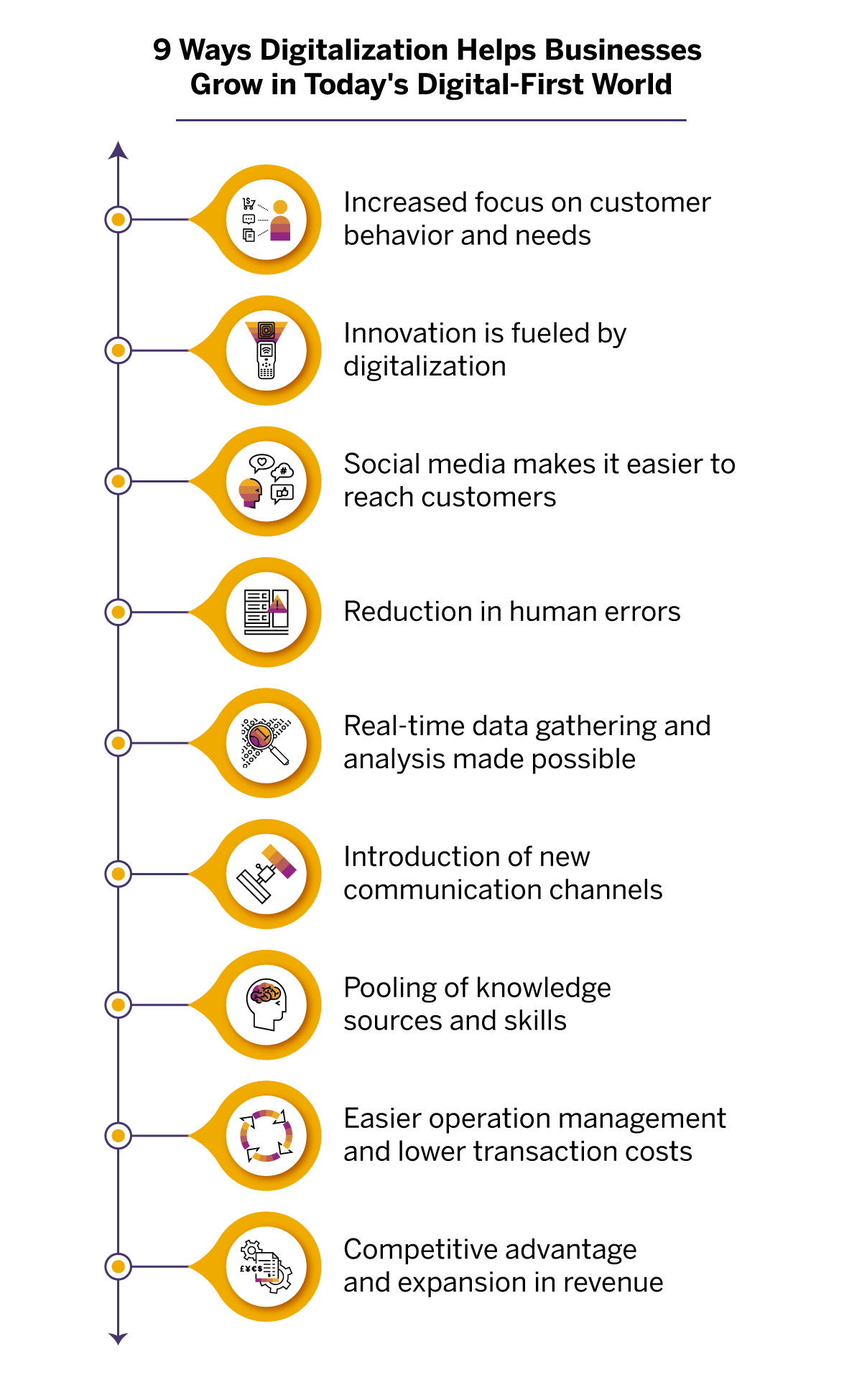As per the OECD, the digital revolution has a huge influence on business, bringing both opportunities and challenges. E-commerce, big data, machine learning, Artificial Intelligence (AI), and the Internet of Things (IoT) are all interconnected phenomena that will significantly boost the economy’s productivity. The consequences of these radical developments are moving beyond the realm of business now. However, millions of lives will be disrupted if conventional economic and societal paradigms, as well as the established marketplaces, are disrupted. Thus, it is vital to prepare ahead to ensure that appropriate policies and institutions are in place to make the most of these developments.
Today’s organizations generate a lot of data, and the digital asset management of the collected data is necessary to take advantage of the same. The digital era has given birth to ideas and concepts that were before unimaginable. Digitization, digitalization, and digital transformation are three of them. It’s difficult to tell the difference between them because they’re often used interchangeably. However, knowing the difference is critical for the organization’s business development team as they aim to welcome them on their technological travels.
Difference between Digitization, Digitalization, and Digital Transformation
The terms digitization, digitalization, and digital transformation all appear to be the same and are often a source of confusion, but these are certainly very different.
In simple terms, Digitization focuses more on internal optimization of processes like automating tasks and minimizing paperwork. Digitalization goes far beyond that. It refers to digital asset management that helps your firm achieve higher growth, among other benefits.
Digitization is crucial for digitalization. It is used to convert information from analog to digital format. At the same time, digitalization uses digital technologies and data to create new opportunities that change the way customers and businesses interact with each other.
Digital transformation is the actual corporate transformation that is made possible by digitalization. The term ‘digital’ in the name is a bit misleading; the essence of digital transformation is a change in business processes or business culture, implemented via technology.
Impact of digitalization on enterprises
To be competitive in this new commercial and economic situation, the tactics and technology adopted by organizations need to change. Most executives see the strategic value of technology as an important part of doing business, not just as a source of cost savings.
In 2004, Target outsourced its web presence, which is considered supplementary, to Amazon. Target redesigned its location and devised a new and updated design that blurred the line between e-commerce and physical stores. Tremendous changes were made in more than 400 stores, which were rebuilt and outfitted using modern technology. Innovation in services also took place in online ordering, in-store pickup, and curbside food pickup.
These investments provided a huge advantage to Target during the pandemic. The sales through curbside pickup service increased by 500% YOY in Q4 of 2020. The market share of the company increased by $9 Billion, adding $15 Billion to its revenue.
Another example is Hasbro, the toy and gaming firm that invested significant money into its digital and data strategy, including digital asset management. The collected data was used for targeted marketing efforts across many platforms, including a more robust social media push. The information allowed the corporation to understand its clients better and provide parents with appropriate toy and game recommendations. In Q4 of 2020, Hasbro reported more than $1 Billion in online sales, an increase of 43% YOY.
Digitized change lies in utilizing new advancements to guarantee the adaptability and versatility requested by clients. Applications providers and technology and infrastructure merchants have acknowledged and profited from the force of innovative advancements like cloud, big data, mobile, social, sensors, and so on.
Here are nine ways how digitalization impacts medium and large-scale businesses and helps them to grow in today’s digital-first world:
- Increased focus on customer behavior and needs
Customer purchasing patterns have changed drastically over time. According to Statista, around 80% of consumers shopped online across the globe in 2020. With the growing trend of online purchasing, consumers may not only take advantage of the convenience of having the goods delivered to their door, but they can also compare a brand’s products and services to those of companies in other industries.

Today, every brand wants to improve the online product purchase experience for its consumers and increase the efficiency of all processes to satisfy their expectations.
- Innovation is fuelled by digitalization
Digitalization has a significant influence on innovation. As technologies become more advanced and innovative to meet customers’ demands, new industry trends and possibilities are likely to emerge.
Online banking is one of the most well-known examples of innovation propelled by digitalization. With quick, dependable, and secure mobile applications, you can effortlessly transfer or manage your money. You can even use the online banking app to pay your prepaid and postpaid bills, without having to leave your house.
- Social media makes it easier to reach customers
Social media platforms such as Facebook, Instagram, Twitter, Snapchat and various others have gained a significant influence due to digitalization. Businesses see these platforms as a chance to expand and enhance brand exposure in the digital era. Now, an online user is most likely to come across content created by various organizations to promote their brands, launch new products etc. As per McKinsey, the importance of online presence has increased post the pandemic, and only about 20% of B2B customers are expected to return to in-person sales.

Rolex is a superb example of a traditional company that uses social media to increase its brand image. Rolex stands for class, and appeals to the customers by emphasizing its unique, timeless products. The luxury appeal of its high-value products is enhanced with the help of sleek and minimalist visuals in its photography, videos, and other visual work. Such high-quality product photographs enable the brand to have a higher recall value and stand apart from competitors.
- Reduction in human errors
Business operations have become more streamlined because of digitalization, resulting in lower operating costs. Automation has taken away repetitive and mundane tasks from human employees, lowering the chances of errors. For example, people-powered data entries take a long time to be vetted, verified and cleaned up before they can be used for any purpose. Data that is incomplete or incorrect can stymie product launches and bias strategic analysis. All these hurdles can be done away with through digitalization.
- Real-time data gathering and analysis is possible
Over the past few decades, organizations have relied on data collected from various sources, manual data cleansing and standardization. This traditional analytical model is labor-intensive, costly, time-consuming, and depends too much on the skills of data analysts.
Digital media marketers can now capture data, store it, analyze it and communicate results, all in a matter of minutes. This provides businesses with valuable customer knowledge in one place. Marketers can also look at campaigns to see what’s working and what’s not, so businesses can quickly adapt to the current trends to improve their results.
- Introduction of new communication channels
The use of digital technology has resulted in the introduction of new communication channels as well as a rise in a company’s digital presence. Emails, smartphone apps, and social media are just a few examples of the current communication methods. Forward-looking companies are aiming at creating a seamless omnichannel approach for their customers. Here, their experience of interacting with the company using numerous digital communication channels is smooth and enjoyable.
- Pooling of knowledge sources and skills
We now have access to limitless experiences and data, thanks to digitalization. Every business can utilize information that exists outside conventional bounds. Similarly, companies that understand how to bring collaborative groups together can grow and generate surplus economic value. Digitization allows diverse individuals to collaborate, bridging the gap between IT and non-IT departments and changing the way firms generate value.
- Transaction costs are lower
Documentation, reconciliation, mail generation, calling, data entry, overtime, and supervision are those areas where digitalization facilitates the reduction in costs. Online businesses see easier operation management, which leads to lowered transaction costs.
- Expansion in Revenue
The primary goal of any business is income generation; higher the revenue, greater the growth. A colossal effect impact on revenue generation is observed in organizations that have introduced digital changes. Using innovative digital solutions in your organization provides you a competitive advantage, and a well-thought-out digitalization strategy may help you rethink procedures, enhance quality, and promote consistency.

In conclusion
Thus, digitalization is more an opportunity than a challenge for all companies, regardless of their industry, location, or market. Digitally driven advances have not only changed the enterprise but have redefined the scope of leadership. To explore the full potential of such a change, choose an experienced partner like SAP that can combine multi-industry expertise with state-of-the-art technical capabilities.



